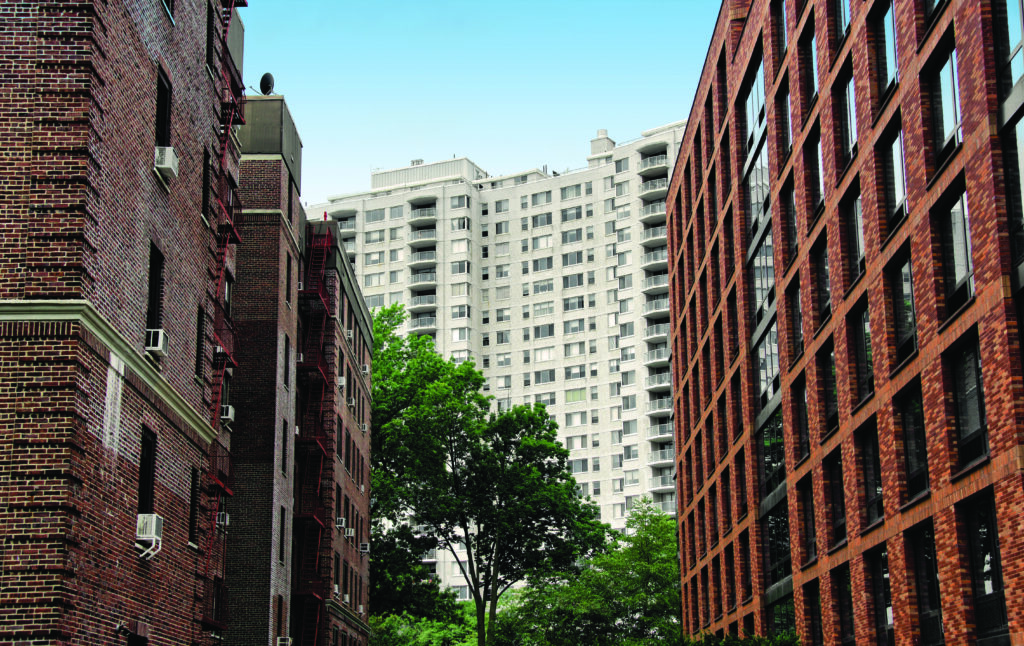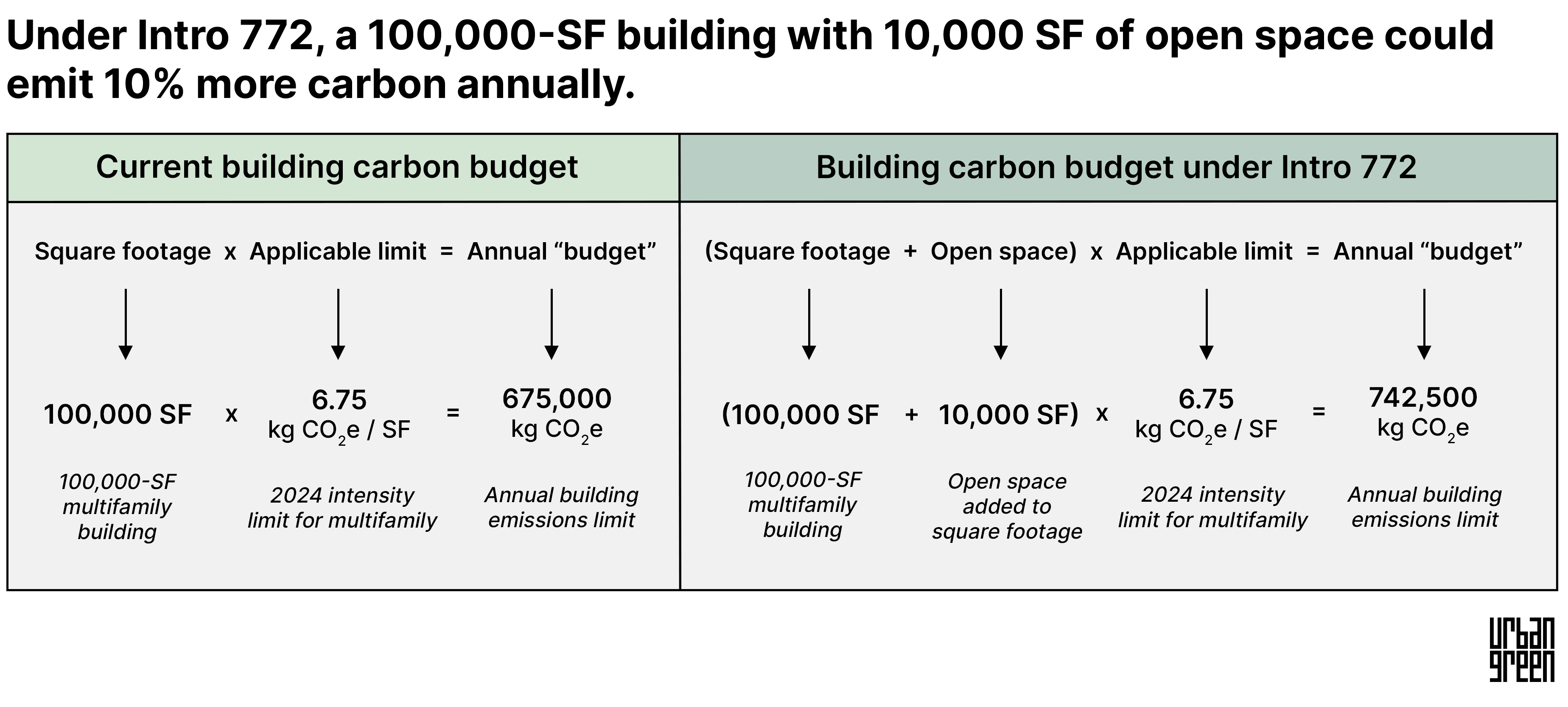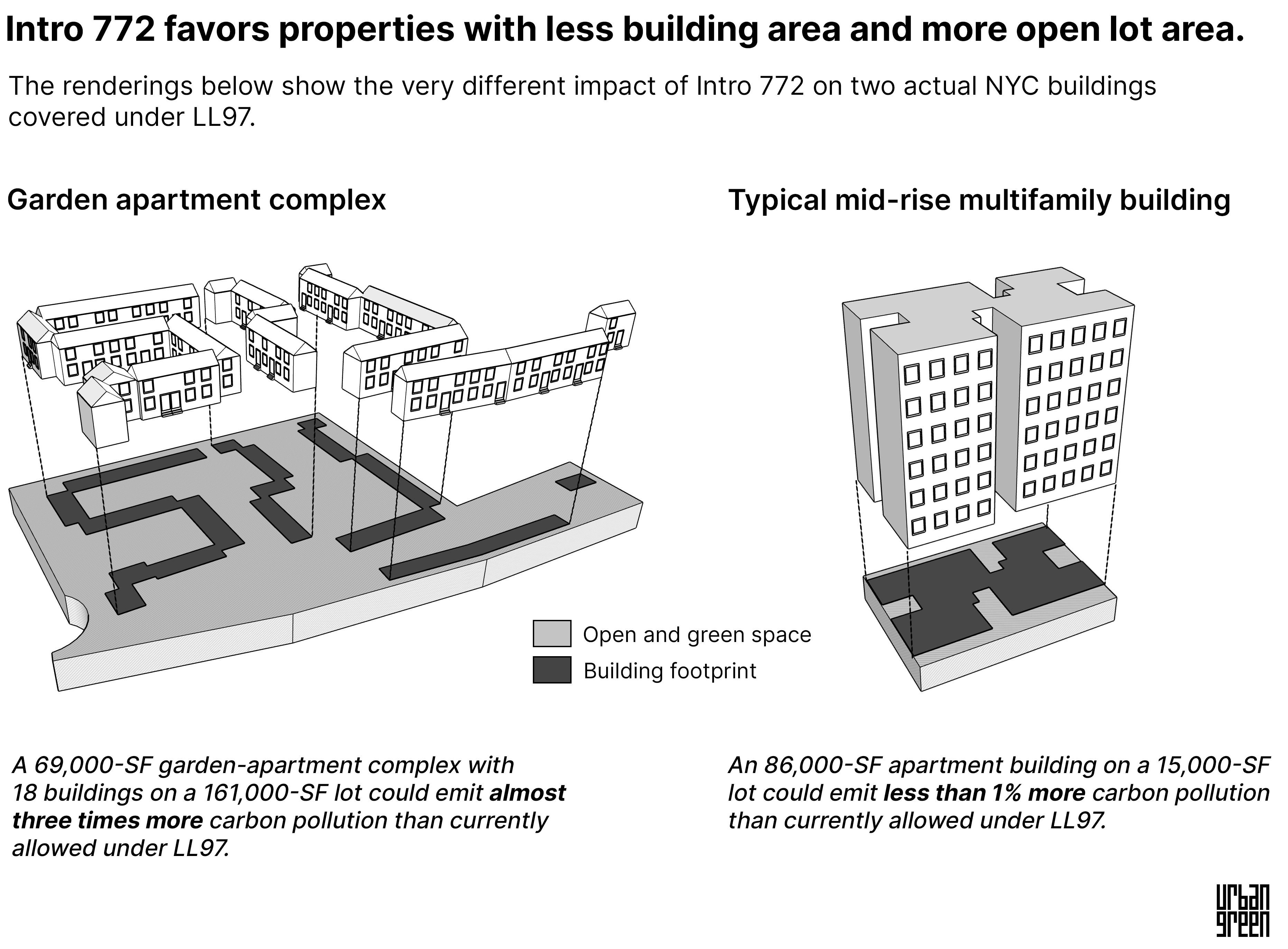A potential gaping hole in the law and a major roadblock to city and state climate targets.
Original publication by Urban Green Council • November 13, 2024
Revised January 15, 2025
A City Council bill introduced last April aims to significantly weaken Local Law 97 (LL97) for co-ops, condos and garden-apartment complexes. LL97 advocates and industry stakeholders are taking note, in part because the bill—Intro 772—has attracted media attention and is sponsored by roughly half the City Council.
Many have said the bill is a cynical ploy to gut LL97, and DEC Commissioner Rit Aggarwala called it “absolutely wrong.” Others have framed it as practical and necessary.
Below, we cut through the noise with facts and data that shed light on the proposal and its impact. We also point to solutions that address many of the concerns behind the bill.

Highlights
- Intro 772 proposes a questionable metric for carbon accounting and a decade-long suspension of penalties.
- The bill would allow 11 percent more carbon pollution every year in a typical co-op or condo, and effectively grant a total exemption to garden-apartment complexes.
- It would also give a free pass until 2036—and significantly reduced penalties thereafter—for about one-third of all residential buildings with emissions limits.
What does Intro 772 propose?
Intro 772 proposes two fundamental changes to how LL97 regulates co-ops, condos and garden-apartment complexes:
- A new accounting that includes “ground floor open and green spaces” in a building’s floor area when calculating greenhouse gas (GHG) emissions limits.
- A decade-long suspension of all penalties for many buildings, followed by another 10 years of significantly reduced penalties.
Garden-apartment complexes include multiple small residences spread out on one or more large properties and provided with common services like water and sewers. Individually, these homes would not meet the size threshold for LL97, but collectively they may if they’re owned and managed together without individual responsibility for HVAC and hot water systems.
How would the proposed GHG accounting change LL97?
LL97 sets an annual allowable carbon budget for each covered building using a GHG intensity limit: emissions per square foot of building area. Intro 772 would allow co-ops, condos and garden-apartment complexes to count “ground floor open and green space” as building area in the calculation. This addition would artificially increase a building’s area and, as a result, its annual allowable carbon budget, as shown in Figure 1 below.
Figure 1

A questionable metric with no precedent
LL97 focuses on operational energy and carbon, or the energy and emissions needed to run a building. Green space, while environmentally beneficial, doesn’t change the energy required to operate a building. It does sequester some carbon in soil, trees and other growth—certainly good for the environment, but not relevant for a metric focused on carbon intensity in buildings. Indeed, we haven’t found a single precedent worldwide where the open area of a property is included in energy or carbon use intensity calculations.
Some proponents have claimed that Intro 772 would justifiably give carbon credit for green space. Even accepting this premise, the math doesn’t add up. For most buildings, the proposed accounting produces an extremely inflated and unscientific benefit for small tracts of undefined “open and green space.” According to the EPA, it takes 1.2 acres of forest a full year to sequester one metric ton of CO2—far more land and trees than on any NYC property outside of the city’s major parks.
Disproportionate impact favoring smaller buildings with open grounds
The proposed GHG accounting would also have a very disparate impact on covered buildings because New York City co-ops and condos can have vastly different amounts of building area and “open and green space.” This wide range in the ratio of building area to open lot area is clearly visible in the contrast between a medium-rise multifamily building on a dense block and a spacious garden-apartment complex, as shown in Figure 2.
Figure 2

An exemption in sheep’s clothing for garden-apartment complexes
Citywide, the disparity in the impact of the proposed GHG accounting is even more stark. The median building would see an 11 percent increase in allowable carbon pollution. But two percent of affected co-ops and condos—including many garden-apartment complexes—would see an enormous carbon windfall allowing them to emit twice as much carbon or even more. That’s a permanent LL97 exemption in all but name.
Figure 3
How would the free pass on penalties affect covered buildings?
Intro 772 also proposes a 10-year suspension of penalties, followed by significantly reduced penalties through 2045, for all co-ops and condos with an average assessed value of $65,000 per unit or less. Assessed value is NYC’s system to determine property taxes, and it represents a small fraction of true market value.
Under LL97, about 6,000 co-ops and condos are subject to annual GHG emissions limits—about two-thirds of all residential buildings with GHG limits. Intro 772 would give more than 3,000 of these co-ops and condos a completely free pass on LL97 until 2036, followed by reduced penalties until 2045. That’s a free pass for about one-third of all residential buildings with GHG limits under LL97, leaving a gaping hole in the law and creating a major roadblock to city and state climate targets.
Figure 4
Solutions are in plain view
LL97 is an ambitious law, and there is no doubt that co-ops, condos and garden-apartment complexes need support. Over the next 25 years, many face a major transition from fossil fuels to highly efficient electric heat pumps.
But the reality is that improvements don’t need to happen overnight and most multifamily buildings have a straightforward and actionable path to 2030 compliance that prioritizes energy efficiency.
The law also includes significant flexibility to help building owners and management boards strategically decarbonize to meet LL97 in a manner that works for their building’s equipment turnover, capital cycles and other needs. Flexibility measures include:
- Credit for installing heat pumps, solar panels and batteries;
- A metric that inherently rewards prior upgrades, since efficiency improvements lower a building’s carbon footprint;
- The ability to purchase GHG offsets from the Affordable Housing Reinvestment Fund;
- Two years of breathing room for buildings making good faith efforts to comply;
- Adjustments to GHG limits for buildings facing significant financial constraints, with financial health metrics designed for co-ops and condos;
- Leniency for buildings in extreme financial distress; and
- Extensions for compliance reports because of data issues.
Significant financial support is already available to help manage upfront costs, and more is on the way too. The state offers major incentives for energy efficiency and electrification work, and federal dollars are starting to flow from the Inflation Reduction Act. Once passed by the City Council, the new J-51 program passed by the City Council will support upgrades to about 1,300 low- and moderate-income co-ops projected to be over LL97’s 2030 limits.
Given the proposed windfall for garden apartments in Intro 772—plus a prior bill to exempt those buildings outright and an ongoing lawsuit filed by one of the sector’s more vocal owners—it’s easy to see why many have concluded the bill is yet another cynical ploy to repeal LL97.
Now that the law is officially underway with many flexible compliance options and substantial support available, Urban Green is focused on identifying where additional help is needed and finding constructive paths to ensure all buildings can reach LL97 targets.
Related resources
Local Law 97
NYC’s groundbreaking climate legislation sets carbon emissions caps for large buildings that began in 2024.
LL97: Unpacking the Proposed Rules (2024)
Join us on October 9 for a webinar with the Department of Buildings to understand the new proposed rules for Local Law 97.
Explore our NYC building data hub
Learn more about NYC's buildings and their energy use in this interactive data hub.
Methodology notes
- Overall analysis methodology
- To approximate the amount of “open and green space” for a property we used public data from NYC’s PLUTO dataset and Property Information Portal.
- We utilized a dataset published by the NYC Department of Finance that lists co-ops and condos that must sign prevailing wage affidavits to determine the properties that would likely receive a 10-year exemption under Intro 772’s assessed value provision. The prevailing wage requirements apply to properties that have an average unit assessed value of more than $60,000, whereas the proposed average unit assessed value threshold in Intro 772 is $65,000. This small discrepancy between assessed value thresholds could lead our analysis to slightly underrepresent the number of co-ops and condos that would be exempt from LL97 penalties due to Intro 772.
- Figure 2 data (all measurements in sq. ft. unless otherwise specified)
- Garden Style
- Lot Area: 161,300
- Building Area: 68,700
- Footprint: 34,400
- Estimated Open Space: 126,900
- Emissions Cap Increase: 184.7%
- Apartment Style
- Lot Area: 15,000
- Building Area: 86,000
- Footprint: 14,300
- Estimated Open Space: 700
- Emissions Cap Increase: 0.8%
- Garden Style